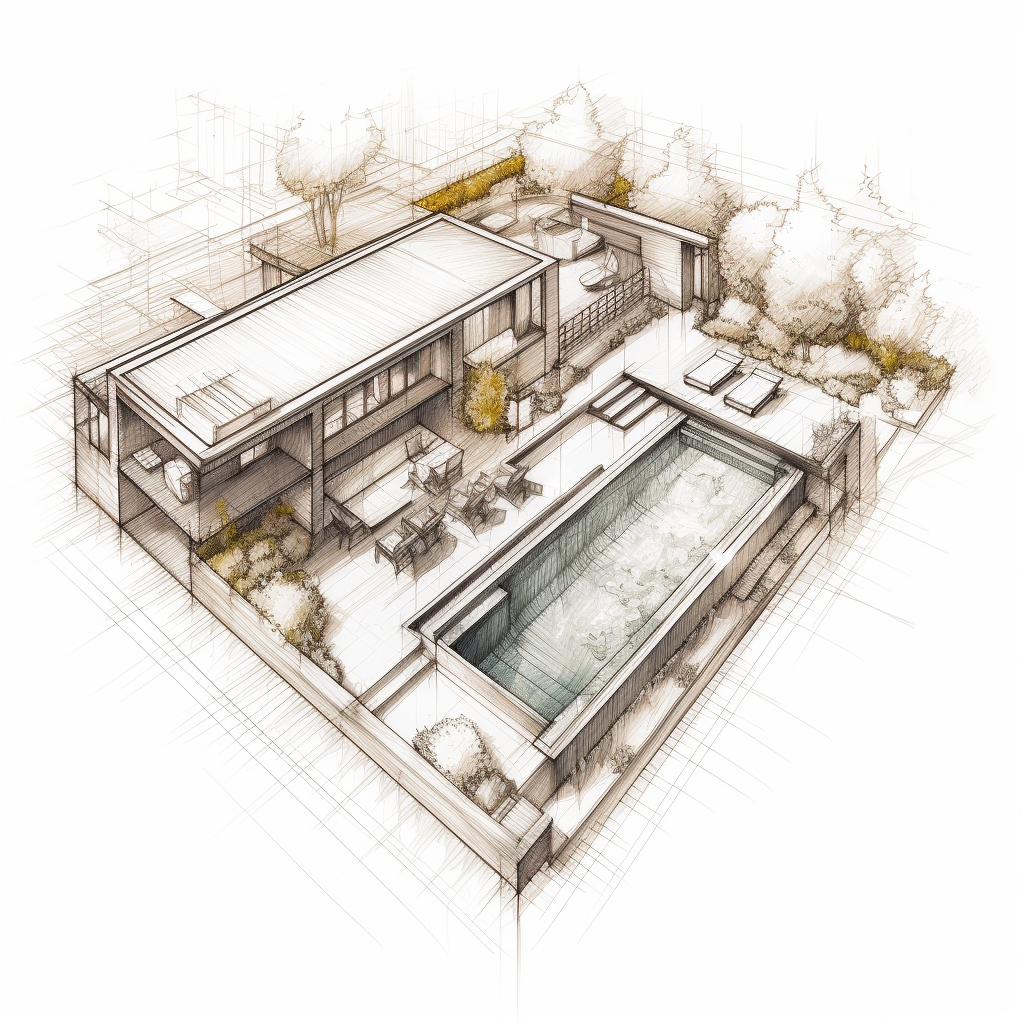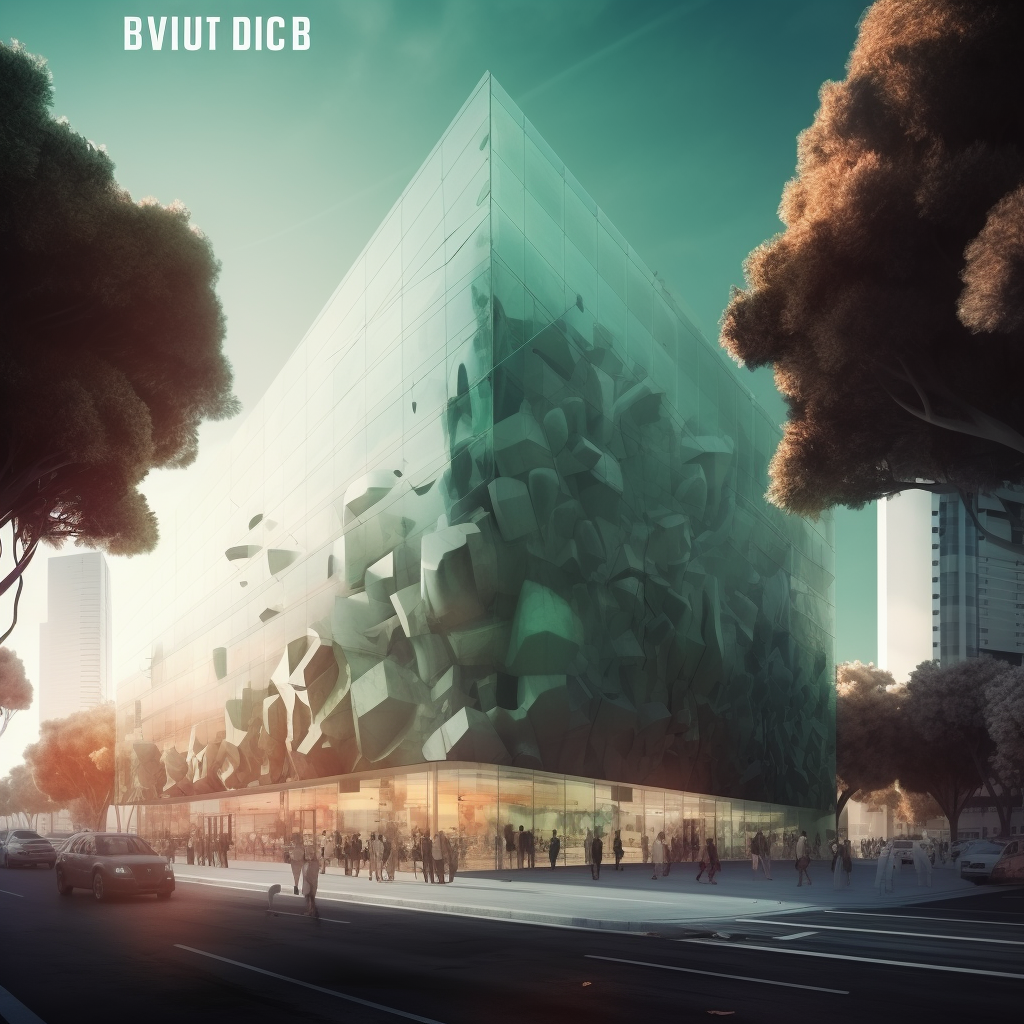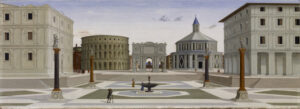By Greg Andoll, Assoc. AIA, NOMA, Architectural Prompt Engineer
By the time you finish reading this article, there will probably be yet another major advancement in Artificial Intelligence (AI). While much of the recent buzz has focused on ChatGPT, which is text to text, it is AI’s text to image and image to image algorithms that may be of particular interest to architects and designers. These algorithms create original designs or produce renderings of existing designs by following a user’s natural language prompts. The results are immediate, often stunning, and sometimes downright spooky.
Let’s dive in. Using the text to image algorithm Midjourney (MJ) to generate a design based on a client’s brief, I entered this prompt: “architectural freehand sketch of a two-level house with flat roof, pool, landscaping with shrubs, pool with diving board birds eye view”. In about 60 seconds MJ generated this design (and three alternatives).

Figure 1 AI Generated House using Midjourney
To be clear, MJ did not search for this design. It created it based solely on the above natural language prompt. The significance of this cannot be overstated. Before AI, computers processed and organized information. After AI, computers now also create information; in this case a plausible architectural parti. Spooky.
AI can also be used for competitions where more abstract ideas and visual presentations are paramount. Again, using MJ, I entered the prompt: “competition entry for an urban library. brutalist lower walls transition to translucent. diffused style. street level view”. The original result was not what I wanted, but after a few regenerations, further prompts, and using MJ’s tools, the algorithm eventually returned this design.

Figure 2 AI Generated Library using Midjourney
This is closer to the concept I had in mind. (A library where knowledge/order (smooth light walls) emerges from ignorance/chaos (rough dark foundation)). Of course, it would be unethical to submit Figure 2 as an original competition entry (even though it is original). Rather, like all AI generated images, Figure 2 is best used as a tool to develop further designs.
AI is not limited to whole buildings. It can be particularly useful when developing patterns and textures. Still in Midjourney (there are others like Dall-E) the prompt “tile pattern rough red white blue green only lilies” yielded these ersatz tiles even with the misspelling. Using this image as a basis, one can engage a skilled artisan to make copies or perform an image search to source similar tiles.

Figure 3 AI generated tile pattern using Midjourney
While these examples showcase some of AI’s astonishing abilities, they also point out some of its current problems.
Artificial Intelligence is error prone. Note that there is no “diving board” in the house design (Figure 1) even though the prompt explicitly calls for one. AI often inserts unwanted nonsense text (Figure 2) or other odd features that developers call “hallucinations”. Once an image is generated, it cannot be altered. AI cannot place a design in a specific location making it impossible to show context. To show context, or to add the diving board, the images must be exported to another program like Photoshop.
Further, despite AI development around Natural Language Processing (NLP), there is an art to writing nuanced prompts to approximate desired results. Longer prompts do not yield more precise results; and a slight change in wording could yield vastly different designs. Command of language, syntax, and an encyclopedic knowledge of design terms and architectural history are essential, as is expertise in a program’s unique tools. Yet even if so equipped, using AI’s current abilities as a tool to produce precise designs is like performing surgery with an axe.
A more precise use of AI, however, takes the opposite approach. AI can take an architect’s existing design to quickly generate stunning renderings. For example, a designer turned this back-of-the-envelope sketch into a photorealistic rendering using another AI program called Stable Diffusion.

Figure 4 Sketch to AI Rendering using Stable Diffusion
Here is a tutorial . Another useful AI program is Veras, a Revit plug in which takes a 3D drawing created in Revit to produce renderings that are far beyond Revit’s internal capabilities. Here is a another tutorial.
 Figure 5 Revit to AI Rendering using Veras
Figure 5 Revit to AI Rendering using Veras
Whether generating design concepts, or producing renderings, clearly AI’s current practical use is during a project’s beginning phases.
“Not every single project (in our office) is using (AI) but let’s say most – I’m encouraging everybody who’s working on competitions and early ideation to see what comes up and just to have a larger repertoire,” Patrik Schumacher, Principal at Zaha Hadid Architects. Dezeen May 2, 2023
But this may change. When it comes to AI, it is best to think about what its capabilities will be in the near future, not what it does now. Development is exponential, not linear. Driving this growth is a phalanx of AI startups that are beta testing tools that will make the conceptual designs and renderings described above seem quaint.
Based on what they promise, it is conceivable that in the future an architect will be able to prompt an AI algorithm by saying (not typing): “A two story 90,000 sf elementary school for 700 students at GPS coordinates… LEED Platinum for under $16 million. Use (firm or individual) previous designs as a style template.” AI then produces a code compliant design, complete with detailed floorplans, sections, elevations, and an .STL file. Not thoroughly satisfied with the result, the architect may then say something like “warmer interior color palette, larger windows”, or make any number of changes to ultimately achieve her vision. Maybe.
What does this mean for our profession? Clearly AI will steer our industry to a better or worse place. A worse place is one where public obliviousness, nonexistent professional protocols, and a laissez faire regulatory climate leads to the rise of the bots and collapse of the profession as we know it. A better place is one where our industry proactively educates the public, establishes (and enforces) professional standards, and supports legislation that will limit AI to perform mundane tasks (producing CDs, writing specs, reviewing submittals, etc.); leaving the architect to focus almost exclusively on design (even if such designs are developed in part by AI). After all, design is why most of us got into this field in the first place.
Whether AI-based design drives us to a better place, worse place, or remains a mere shiny object that peaked our collective curiosity in the spring of 2023 remains to be seen. Whatever the case, prudent practitioners will advantageously position themselves by learning AI, keeping informed of its rapid development, and integrating it in their current designs. Even in its current shiny objects phase, AI is a powerful tool for ideation and producing renderings.
Artificial Intelligence poses many challenges, unknowns, and opportunities. We are clearly entering uncharted waters…on a ship with no compass…in a fog. Here there be dragons.
Comments are welcome and can be sent to greg.a.andoll@gmail.com or to this publication.


